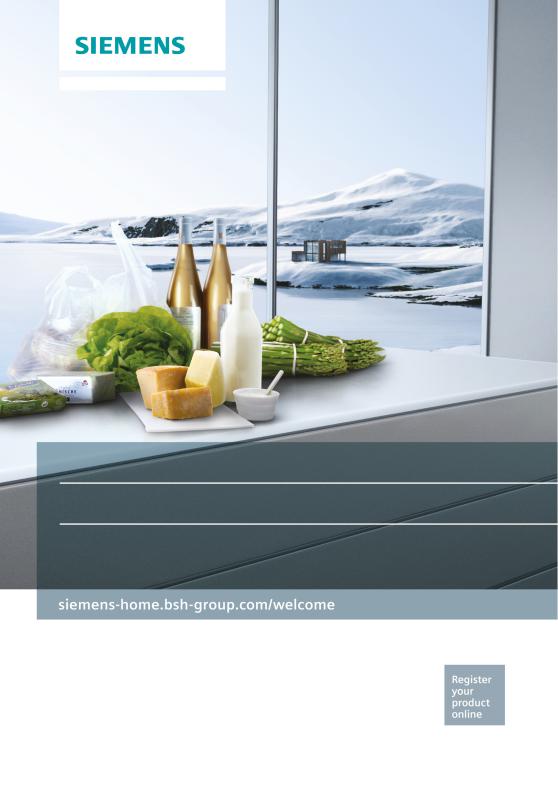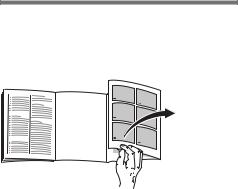Siemens KG56NHI20R User Manual

Fridge-freezer Холодильно-морозильная комбинация
Soğutucu/Dondurucu kombine cihazı
KG..N..
HQ ,QVWDOODWLRQ LQVWUXFWLRQV DQG LQVWUXFWLRQV IRU XVH
UX Βηλμκνδπβω ιθ ζθημΪΰν β χδλιενΪμΪπββ
WU 0RQWDM YH NXOODQPD N×ODYX]X

en Table of Contents |
|
Safety and warning information ........... |
4 |
Information concerning disposal ......... |
7 |
Scope of delivery ................................... |
8 |
Installation location ................................ |
8 |
Aligning the appliance .......................... |
8 |
Observe ambient temperature |
|
and ventilation ........................................ |
9 |
Connecting the appliance .................... |
9 |
Getting to know your appliance ........ |
10 |
Switching on the appliance ................ |
11 |
Setting the temperature ...................... |
12 |
Special functions .................................. |
12 |
Alarm function ...................................... |
13 |
Home Connect ..................................... |
14 |
Usable capacity .................................... |
19 |
Refrigerator compartment .................. |
20 |
Super cooling ....................................... |
22 |
Freezer compartment .......................... |
22 |
Max. freezing capacity ........................ |
22 |
Freezing and storing food .................. |
23 |
Freezing fresh food ............................. |
23 |
Super freezing ...................................... |
24 |
Thawing frozen food ............................ |
25 |
Interior fittings ....................................... |
25 |
Sticker “OK” .......................................... |
26 |
Switching off and disconnecting |
|
the appliance ........................................ |
26 |
Cleaning the appliance ....................... |
27 |
Light (LED) ............................................ |
28 |
Tips for saving energy ........................ |
28 |
Operating noises ................................. |
29 |
Eliminating minor faults yourself ....... |
30 |
Appliance self-test ............................... |
32 |
Customer service ................................. |
32 |
ru Coдepжaниe |
|
Укaзaния пo бeзoпacнocти |
|
и пpeдyпpeждeния .............................. |
33 |
Укaзaния пo yтилизaции ................... |
37 |
Oбъeм пocтaвки .................................. |
37 |
Mecтo ycтaнoвки ................................. |
38 |
Bыpaвнивaниe прибора .................... |
38 |
Teмпepaтypa oкpyжaющeй cpeды |
|
и вeнтиляция ........................................ |
38 |
Подключение бытового прибора ... |
39 |
Знакомство с бытовым прибором . 40 |
|
Включение прибора .......................... |
41 |
Уcтaнoвкa тeмпepaтypы .................... |
42 |
Cпeциaльныe фyнкции ...................... |
42 |
Предупредительная функция .......... |
43 |
Home Connect ..................................... |
44 |
Пoлeзный oбъeм ................................. |
51 |
Xoлoдильнoe oтдeлeниe ................... |
51 |
Cyпepoxлaждeниe .............................. |
53 |
Mopoзильнoe oтдeлeниe .................. |
54 |
Maкc. пpoизвoдитeльнocть |
|
зaмopaживaния ................................... |
54 |
Зaмopaживaниe и xpaнeниe |
|
пpoдyктoв ............................................. |
55 |
Зaмopaживaниe cвeжиx |
|
пpoдyктoв питaния ............................. |
55 |
Cyпepзaмopaживaниe ....................... |
56 |
Paзмopaживaниe пpoдyктoв ............ |
57 |
Cпeциaльнoe ocнaщeниe ................. |
57 |
Haклeйкa «OK» ................................... |
59 |
Bыключeниe прибора и вывoд |
|
eгo из экcплyaтaции .......................... |
59 |
Чистка прибора .................................. |
60 |
Ocвeщeниe (нa cвeтoдиoдax) .......... |
61 |
Kaк cэкoнoмить элeктpoэнepгию .. |
61 |
Paбoчиe шyмы ..................................... |
62 |
Caмocтoятeльнoe ycтpaнeниe |
|
мeлкиx нeиcпpaвнocтeй ................... |
63 |
Caмoпpoвepкa приборa ................... |
65 |
Сервисная служба ............................. |
66 |

tr İçindekiler |
|
Güvenlik ve ikaz bilgileri ..................... |
67 |
Giderme bilgileri ................................... |
70 |
Teslimat kapsamı ................................. |
71 |
Cihazın kurulacağı yer ......................... |
71 |
Cihazın doğru konumlandırılması |
..... 72 |
Mekan sıcaklığına ve havalandırmaya |
|
dikkat edilmelidir .................................. |
72 |
Cihazın elektrik şebekesine |
|
bağlanması ............................................ |
72 |
Cihaz özelliklerinin öğrenilmesi ......... |
73 |
Cihazın açılması ................................... |
75 |
Sıcaklık derecesinin ayarlanması ...... |
75 |
Özel fonksiyonlar .................................. |
75 |
Alarm fonksiyonu ................................. |
76 |
Home Connect ..................................... |
77 |
Kullanılabilen hacim ............................. |
82 |
Soğutucu bölmesi ................................ |
82 |
Süper soğutma ..................................... |
84 |
Dondurucu bölmesi ............................. |
85 |
Azami dondurma kapasitesi .............. |
85 |
Besinlerin dondurulması |
|
ve depolanması .................................... |
85 |
Taze besinlerin dondurulması ........... |
86 |
Süper dondurma .................................. |
87 |
Dondurulmuş besinlerin buzunun |
|
çözülmesi .............................................. |
88 |
Dolap ...................................................... |
88 |
Çıkartma "OK" ...................................... |
89 |
Cihazın kapatılması, cihazın |
|
tamamen kapatılması .......................... |
90 |
Cihazın temizlenmesi .......................... |
90 |
Aydınlatma (LED) ................................. |
91 |
Enerji tasarrufu ..................................... |
92 |
Çalışma sesleri ..................................... |
92 |
Basit hataları kendiniz |
|
giderebilirsiniz ....................................... |
93 |
Cihazın kendini test etmesi ................ |
95 |
Müşteri Hizmetleri ................................ |
95 |

en
Safety and warning information
Before you switch ON the appliance
Please read the operating and installation instructions carefully! They contain important information on how to install, use and maintain the appliance.
The manufacturer is not liable if you fail to comply with the instructions and warnings. Retain all documents for subsequent use or for the next owner.
Technical safety
The tubes of the refrigeration circuit convey a small quantity of an environmentally friendly but flammable refrigerant (R600a). It does not damage the ozone layer and does not increase the greenhouse effect. If refrigerant escapes, it may injure your eyes or ignite.
If damage has occurred
■Keep naked flames and/or ignition sources away from the appliance,
■thoroughly ventilate the room for several minutes,
■switch off the appliance and pull out the mains plug,
■inform customer service.
The more refrigerant an appliance contains, the larger the room must be in which the appliance is situated. Leaking refrigerant can form a flammable gas-air mixture in rooms which are too small. The room must be at least 1 m³ per 8 g of refrigerant. The amount of refrigerant in your appliance is indicated on the
rating plate inside the appliance.
If the power cord of this appliance is damaged, it must be replaced by the manufacturer, customer service or a similarly qualified person. Improper installations
and repairs may put the user at considerable risk.
4
Repairs may be performed by the manufacturer, customer service or a similarly qualified person only.
Only original parts supplied by the manufacturer may be used. The manufacturer guarantees that only these parts satisfy the safety requirements.
Do not use multiple sockets, extension leads or adapters.
Important information when using the appliance
■Never use electrical appliances inside the appliance (e.g. heater, electric ice maker, etc.). Explosion hazard!
■Never defrost or clean the appliance with a steam cleaner! The steam may penetrate electrical parts and cause a short-circuit. Risk of electric shock!
■Do not use pointed or sharpedged implements to remove frost or layers of ice. You could damage the refrigerant tubes. Leaking refrigerant may cause eye injuries or ignite.
en
■Do not store products which contain flammable propellants (e.g. spray cans) or explosive substances in the appliance. Explosion hazard!
■Do not stand on or lean heavily against base
of appliance, drawers or doors, etc
■For defrosting and cleaning, pull the mains plug out or switch off the fuse. Do not pull out the mains plug by tugging on the power cord.
■Store high-percentage alcohol tightly closed and standing up.
■Keep plastic parts and the door seal free of oil and grease. Otherwise, parts and door seal will become porous.
■Never cover or block the ventilation openings of the appliance!
5
en
■Avoiding placing children and vulnerable people at risk:
At risk are children, people who have limited physical, mental or sensory abilities, as well as people who have inadequate knowledge concerning safe operation of the appliance.
Ensure that children and vulnerable people have understood the hazards.
A person responsible for safety must supervise or instruct children and vulnerable people who are using the appliance.
Only children from 8 years and above may use the appliance.
Supervise children who are cleaning and maintaining the appliance.
Never allow children to play with the appliance.
■Do not store bottled or canned drinks (especially carbonated drinks) in the freezer compartment. Bottles and cans may burst!
■Never put frozen food straight from the freezer compartment into your mouth.
Risk of low-temperature burns!
■Avoid prolonged touching of frozen food, ice or the evaporator pipes, etc.
Risk of low-temperature burns!
Children in the household
■Keep children away from packaging and its parts. Danger of suffocation from folding cartons and plastic film!
■Do not allow children to play with the appliance!
■If the appliance features a lock:
keep the key out of the reach of children!
6

General regulations
The appliance is suitable
■for refrigerating and freezing food,
■for making ice.
This appliance is intended for use in the home and the home environment.
The appliance is suppressed according to EU Directive 2004/ 108/EC.
The refrigeration circuit has been checked for leaks.
This product complies with the relevant safety regulations for electrical appliances
(EN 60335-2-24).
This appliance is intended for use up to a maximum height of 2000 metres above sea level.
en
Information concerning disposal
* Disposal of packaging
The packaging protects your appliance from damage during transit. All utilised materials are environmentally safe and recyclable. Please help us by disposing of the packaging in an environmentally friendly manner.
Please ask your dealer or inquire at your local authority about current means of disposal.
* Disposal of your old appliance
Old appliances are not worthless rubbish! Valuable raw materials can be reclaimed by recycling old appliances.
This appliance is labelled in
accordance with European Directive 2012/19/EU concerning used electrical and electronic appliances (waste electrical and electronic equipment - WEEE). The guideline determines the framework for the return and recycling of used appliances as applicable throughout the EU.
7

en
m Warning
Redundant appliances
1.Pull out the mains plug.
2.Cut off the power cord and discard with the mains plug.
3.Do not take out the trays and receptacles: children are
therefore prevented from climbing in!
4.Do not allow children to play with the appliance once it has spent its useful life. Danger of suffocation!
Refrigerators contain refrigerant
and gases in the insulation. Refrigerant and gases must be disposed
of professionally. Ensure that tubing
of the refrigerant circuit is not damaged prior to proper disposal.
Scope of delivery
After unpacking all parts, check for any damage in transit.
If you have any complaints, please contact the dealer from whom you purchased the appliance or our customer service.
The delivery consists of the following parts:
■Free-standing appliance
■Interior fittings (depending on model)
■Bag containing installation materials
■Operating instructions
■Installation manual
■Customer service booklet
■Warranty enclosure
■Information on the energy consumption and noises
Installation location
A dry, well ventilated room is suitable as an installation location. The installation location should not be exposed to direct sunlight and not placed near a heat source, e.g. a cooker, radiator, etc. If installation next to a heat source is unavoidable, use a suitable insulating plate or observe the following minimum distances from the heat source:
■3 cm to electric or gas cookers.
■30 cm to an oil or coal-fired cooker.
The floor of the installation location must not give way; if required, reinforce floor. If the floor is uneven, compensate with supports.
Distance from wall
When installing the appliance, ensure that the door can be opened by 90°.
Aligning the appliance
Place the appliance in the designated location and align.The appliance must be level and stand securely on the floor. If the floor is uneven, use the front heightadjustable feet. Adjust the heightadjustable feet with a spanner.
Note
The appliance must be vertical. Please align it with a spirit level.
8

Observe ambient temperature and ventilation
Ambient temperature
The appliance is designed for a specific climate class. Depending on the climate class, the appliance can be operated at the following temperatures.
The climate class can be found on the rating plate. Fig. 0
Climate class |
Permitted ambient |
|
temperature |
SN |
+10 °C to 32 °C |
N |
+16 °C to 32 °C |
ST |
+16 °C to 38 °C |
T |
+16 °C to 43 °C |
Note
The appliance is fully functional within the room temperature limits
of the indicated climatic class. If an appliance of climatic class SN
is operated at colder room temperatures, the appliance will not be damaged up to a temperature of +5 °C.
Ventilation
Fig. "
The air on the rear panel and on the side panels of the appliance heats up. Conduction of the heated air must
not be obstructed. Otherwise,
the refrigerating unit must work harder. This increases power consumption. Therefore: Never cover or block
the ventilation openings!
en
Connecting the appliance
After installing the appliance, wait at least 1 hour until the appliance is switched on. During transportation the oil in
the compressor may have flowed into the refrigeration system.
Before switching on the appliance for the first time, clean the interior of
the appliance (see chapter “Cleaning the appliance”).
Electrical connection
The socket must be near the appliance and also freely accessible following installation of the appliance.
m Warning
Risk of electric shock!
If the length of the mains cable is inadequate, never use multiple sockets or extension leads. Instead, please contact Customer Service for alternatives.
The appliance complies with protection class I. Connect the appliance to 220– 240 V/50 Hz alternating current via a correctly installed socket with protective conductor. The socket must be protected by a 10 A to 16 A fuse.
For appliances operated in nonEuropean countries, check whether the indicated voltage and current type match the values of your electricity supply. This information can be found on the rating plate, Fig. 0.
9

en
m Warning
Never connect the appliance
to electronic energy saver plugs.
Our appliances can be used with mains and sine-controlled inverters. Mainscontrolled inverters are used
for photovoltaic systems which
are connected directly to the national grid. Sine-controlled inverters must be used for isolated applications (e.g. on ships or in mountain lodges) which are not connected directly to the national grid.
Getting to know your appliance
Please fold out the illustrated last page. These operating instructions refer
to several models.
The features of the models may vary. The diagrams may differ.
Fig. !
* Not all models.
ARefrigerator compartment
BFreezer compartment
1–18 Controls
19* Butter and cheese compartment
20Camera
21Shelf for small bottles
22Shelf for large bottles
23Light (LED)
24* Bottle shelf
25* Breakfast set
26Cold storage compartment
27Vegetable container with humidity control
28* Ice maker/Ice cube container
29* Frozen food container
Controls
Fig. $
1Temperature display refrigerator
compartment
The numbers correspond to the set refrigerator compartment temperatures in °C.
2Display super cooling
This lights up if super cooling is in operation.
3Temperature display freezer
compartment
The numbers correspond
to the set freezer compartment temperatures in °C.
4Display super freezing
This lights up if super freezing is in operation.
5Display vacation
This lights up when the vacation mode is switched on.
6Display fresh
This lights up when the freshness mode is switched on.
7Eco mode indicator
This lights up when the eco mode is switched on.
8Button mode
Selecting the special functions.
10

9Super button
Used to switch on the functions super cooling (fridge compartment) and super freezing (freezer compartment).
10Setting buttons +/-
The buttons are used to set the temperatures of the refrigerator and freezer compartment.
11lock button
Used to switch on the lock function.
12°C button to select the room and
alarm off
Used to select a room. This is necessary to change its temperature or to switch on certain special functions. Used to switch off the alarm.
13Button “lock” function
If this function is switched on, no settings are possible via
the controls.
14Display alarm off
This lights up if the appliance becomes too warm.
15Display alarm
This lights up if the freezer compartment is too warm.
16Display freeze
This lights up if the freezer compartment is selected.
17Display alarm
This lights up if the fridge compartment becomes too warm.
18Display cool
This lights up if the fridge compartment is selected.
en
Switching on the appliance
1.First insert the plug into the connection on the back of the appliance. Check that the plug has been inserted all the way.
2.Then insert the other end of the cable into the socket.
The appliance is now switched on and a warning signal sounds.
Press the °C button to switch off the audible warning signal.
The alarm display goes out when the appliance has reached the set temperature.
The preset temperatures are reached after several hours. Do not put any food in the appliance beforehand.
The factory has recommended the following temperatures:
■Freezer compartment: -18 °C
■Refrigerator compartment: +4 °C
Operating tips
■After the appliance has been switched on, it may take several hours until the set temperatures have been reached.
■The fully automatic NoFrost system ensures that the freezer section remains free of ice. Defrosting is no longer required.
■If the door cannot be immediately reopened after it has been closed, wait until the resulting low pressure has equalised.
■The front and side panels
of the housing are partly heated slightly.This prevents condensation from forming.
11

en
Setting the temperature
Fig. $
Refrigerator section
The temperature can be set from +2°C to +8°C.
1.Select the refrigerator section using the °C button.
2.Keep pressing the +/- buttons until the required temperature is indicated.
Perishable food should not be stored above +4 °C.
Freezer compartment
The temperature can be set from -16°C to -24°C.
1.Select the freezer compartment using the °C button.
2.Keep pressing the +/- buttons until the required temperature is indicated.
Special functions
Fig. $
Fresh mode
Fresh mode gives food an even longer shelf life.
Switching on:
Press the mode button until the fresh display appears.
The appliance automatically sets the following temperatures:
■Refrigerator section: + 2°C
■Freezer section: remains unchanged
Switching off:
Press the mode button repeatedly until the fresh display goes off.
Eco mode
Eco mode switches the appliance to energy-saving operation.
Switching on:
Press the mode button until the "eco mode" indicator appears.
The appliance automatically sets the following temperatures:
■Refrigerator section: +8°C
■Freezer section: -16°C
Switching off:
Press the mode button until the "eco mode" indicator goes off.
Holiday mode
If leaving the appliance for a long period of time, you can switch
the appliance over to the energy-saving holiday mode.
The temperature of the refrigerator compartment is automatically switched to +14 °C.
Do not store any food in the refrigerator compartment during this time.
Switching on:
Press the mode button repeatedly until the vacation display appears.
The appliance automatically sets the following temperatures:
■Refrigerator section: +14°C
■Freezer compartment: remains unchanged
Switching off:
Press themode button repeatedly until the vacation display goes off.
12

Button lock function
To switch the button lock on and off, press the lock button for 5 seconds.
When the function is switched on, the lock display lights up.
The control panel is now protected against unintentional operation.
Exception to the button lock:
The lock button can be pressed to switch off the button lock or if an audible warning signal sounds.
Alarm function
In the following cases an alarm may be actuated.
Door alarm
The door alarm (continuous signal) switches on if the appliance is left open for too long and alarm appears 1 in the refrigerator section temperature display. Close the appliance to switch the door alarm off again.
Temperature alarm
An interval tone sounds, alarm appears on the temperature display of the freezer compartment 3.
The temperature alarm switches on if the freezer compartment is too warm and the frozen food is at risk of thawing.
en
The alarm may switch on without any risk to the frozen food in the following instances:
■when switching on the appliance for initial use.
■when large quantities of fresh food are placed in the appliance.
Note
Do not refreeze thawing or thawed food. Only ready meals (boiled or fried) may be refrozen.
No longer store the frozen produce for the max. storage period.
The temperature display indicates for 5 seconds the warmest temperature which was reached in the freezer compartment. Then the set temperature is displayed again.
Switching off the alarm
Press the °C button to switch off the audible warning signal.
13

en
Home Connect
This appliance is Wi-Fi-capable and can be remotely controlled using a mobile device.
Note
Wi-Fi is a registered trade mark of the WiFi Alliance.
In the following cases, the appliance functions like a refrigerator without a network connection and can still be manually operated via the controls:
■The appliance is not connected to a home network.
■Home Connect service is not available in the country in which the appliance is set up. For an overview of the countries in which Home Connect is available, see www.homeconnect.com.
Notes
■Please observe the safety information in these operating instructions and ensure that this is still adhered to, even if you operate the appliance via the Home Connect app and are not at home when doing so.
You must also follow the instructions in the Home Connect app.
■If the appliance is being operated by means of the controls on the appliance itself, this mode of operation always has priority. During this time, it is not possible to operate the appliance using the Home Connect app.
Home Connect setup
Notes
■Observe the Home Connect supplementary sheet, which is available for download under http:// www.siemens-home.bsh-group.com with the instructions. To do so, enter the E-number of your appliance in the search field.
■After switching on the appliance, wait at least two minutes until internal device initialisation is complete. Only then start setting up Home Connect.
■To make settings with Home Connect, the Home Connect app must be installed on your mobile device. Please observe the Home
Connect documents supplied for doing this.Follow the steps specified by the app to make the settings.
■If the appliance is not operated for a long time, the Home Connect menu closes automatically. You can find information on how to open the Home Connect menu at the start of the appropriate sections.
Automatic connection with the home network (WLAN)
If a WLAN router with WPS function is available, you can automatically connect the refrigerator to the home network.
1.Press the super button and the
lock button simultaneously to open the Home Connect menu.
The display shows Cn.
Note
Press both buttons at exactly the same time.Button operation is locked if only the lock button is pressed for a longer period. Press the lock button again until the lock is deactivated.
14
2.Press the °C button repeatedly until the displays AC and oF are shown.
3.Press the + button.
The appliance is ready for automatic connection.
The display shows an animation for 2 minutes.
Follow the steps below during this period.
4.Activate the WPS function on the home network router (e.g. using the WPS/WLAN button; information on this topic can be found in the router documentation).
■If the connection is successful, on flashes in the refrigerator display.
You can now connect the refrigerator with the app.
■If the display shows oF, it was not possible to establish a connection.
Check whether the refrigerator is located within the range of the home network (WLAN).
Repeat the process or establish the connection manually.
Manual connection with the home network (WLAN)
If the WLAN router present does not have a WPS function, or if this is unknown, you can manually connect the refrigerator with the home network.
1.Press the super button and the
lock button simultaneously to open the Home Connect menu.
The display shows Cn.
en
Note
Press both buttons at exactly the same time.Button operation is locked if only the lock button is pressed for a longer period. Press the lock button again until the lock is deactivated.
2.Press the °C button repeatedly until the displays SA and oF are shown.
3.Press the + button.
The appliance is ready for manual connection.
The display shows an animation for 5 minutes.
Follow the steps below during this period.
4.The refrigerator has now set up its own WLAN network with the network name HomeConnect.
You can now access this network with your mobile device.
5.Open the settings menu of the mobile device and call up the WLAN settings.
6.Connect the mobile device with the WLAN network HomeConnect. Password: HomeConnect
It can take up to 60 seconds to establish the connection.
7.After successful connection, open the Home Connect app on the mobile device.
The app will search for the refrigerator.
8.As soon as the refrigerator has been found, enter the network name (SSID) and the password (Key) of your own home network (WLAN) into the corresponding fields.
15
en
9.Confirm with the button Transmit to domestic appliances.
■If the connection is successful, on flashes in the refrigerator display.
You can now connect the refrigerator with the app.
■If the display shows oF, it was not possible to establish a connection.
Enter the password again, ensuring that it is spelt correctly.
Check whether the refrigerator is located within the range of the home network (WLAN).
Repeat the process.
Connecting the refrigerator to the Home Connect app
Once the connection between the refrigerator and the home network has been established, you can connect the refrigerator to the app.
1.Press super button and lock button simultaneously to open the Home Connect menu.
The display shows Cn.
Note
Press both buttons at exactly the same time.Button operation is locked if only the lock button is pressed for a longer period. Press lock button again until the lock is deactivated.
2.Press °C button repeatedly until the displays PA (pairing = connect with app) and oF are shown.
3.Press + button to connect the appliance with the app.
The display shows an animation.
As soon as the refrigerator and the app are connected, the display shows on.
4.Open the app and wait until the refrigerator is displayed.
Use Add to confirm the connection between the app and the refrigerator.
If the refrigerator is not automatically displayed, click on Add appliance in the app and follow the instructions. As soon as your refrigerator is displayed, add it with +.
5.Follow the instructions in the app until the process is complete.
■The displays show PA and on.
The refrigerator has been successfully connected to the app.
■If the connection has failed, please check whether the mobile device is connected to the home network (WLAN).
Then connect the refrigerator to the app again.
■When the display shows Er, reset the Home Connect settings and perform set-up again from the beginning.
Verify signal strength
You should verify the signal strength if no connection can be established.
1.Press the super button and the
lock button simultaneously to open the Home Connect menu.
The display shows Cn.
Note
Press both buttons at exactly the same time.Button operation is locked if only the lock button is pressed for a longer period. Press the lock button again until the lock is deactivated.
16
2.Press the °C button repeatedly until the display shows SI. In the second display, a value appears between
0(no reception) and 3 (full reception).
Note
The signal strength should be at least
2.If the signal strength is too low, the connection could be interrupted. Place the router and the refrigerator closer together, ensure that the connection is not disturbed by shielding walls or install a repeater to strengthen the signal.
Activating the cameras
You can use this function to check via the app at any time what is in your refrigerator.Whenever the refrigerator compartment door is closed, the cameras take a photo of the refrigerator compartment and the refrigerator compartment door.
Note
The cameras only take one photo at this moment. This ensures protection of your privacy.
If your refrigerator is connected to both your home network (WLAN) and the Home Connect app, you can activate the cameras:
1.Press super button and lock button simultaneously to open the Home Connect menu.
The display shows Cn.
Note
Press both buttons at exactly the same time.Button operation is locked if only the lock button is pressed for a longer period. Press lock button again until the lock is deactivated.
en
2.Press °C button repeatedly until the displays Ca and oF are shown.
3.Press + button to activate the cameras.
The display shows on, the cameras are activated.
Note
If the cameras are activated and the refrigerator contents are interrogated frequently via the app, this will result in increased data transfer.
Note
Uploading the photos takes up to three minutes.
Note
Various external factors in home network and the Internet can cause transmission problems and pictures to be discarded. These have no effect on the appliance’s basic functions.
Deactivating the cameras:
1.Press super button and lock button simultaneously to open the Home Connect menu.
The display shows Cn.
Note
Press both buttons at exactly the same time.Button operation is locked if only the lock button is pressed for a longer period. Press lock button again until the lock is deactivated.
2.Press °C button repeatedly until the displays Ca and oF are shown.
3.Press+ button to deactivate the cameras.
The display shows oF, the cameras are deactivated.
17
en
Resetting Home Connect settings
If the connection process does not work or you would like to log the refrigerator on to a different home network (WLAN), you can reset the Home Connect settings:
1.Press the super button and the
lock button simultaneously to open the Home Connect menu.
The display shows Cn.
Note
Press both buttons at exactly the same time.Button operation is locked if only the lock button is pressed for a longer period. Press the lock button again until the lock is deactivated.
2.Press the °C button repeatedly until the displays rE and oF are shown.
3.Press the + button.
■The display shows a short animation and then again oF.
The Home Connect settings have been reset.
■If the display shows Er, start the reset again or call customer service.
Customer Service access
If you contact Customer Service, they can access your appliance and view its status after you have given your consent. You need to have your appliance connected to your home network for this.
Further information about Customer Service access and its availability in your country is available under www.homeconnect.com in the Help & Support area.
1.Contact Customer Service.
2.Confirm the start of Customer Service access in the app.
During Customer Service access the symbol CS appears on the control panel.
3.As soon as Customer Service has obtained the necessary data, they end access.
Note
You can interrupt remote diagnosis early by switching off Customer Service access in the Home Connect app.
18

Information on data protection
When your Home Connect refrigerator is connected for the first time to a WLAN network that is connected to the Internet, your appliance transmits the following categories of data to the Home Connect server (initial registration):
■Unique appliance identification (consisting of appliance codes as well as the MAC address of the installed Wi-Fi communication module).
■Security certificate of the Wi-Fi communication module (to ensure a secure IT connection).
■The current software and hardware version of your domestic appliance.
■Status of any previous resetting to factory settings.
This initial registration prepares the Home Connect functions for use and is required only when you want to use Home Connect for the first time.
Note
Note that the Home Connect functions can be used only in conjunction with the Home Connect app. Information on data protection can be accessed in the Home Connect app.
en
Declaration of conformity
BSH Hausgeräte GmbH hereby declares that the appliance which features Home Connect functionality is in accordance with the basic requirements and the other relevant provisions of the directive 1999/5/EC.
A detailed R&TTE Declaration of Conformity can be found online at www.siemens-home.bsh-group.com among the additional documents on the product page of your appliance.
Usable capacity
Information on the usable capacity can be found inside your appliance on
the rating plate. Fig. 0
Fully utilising the freezer volume
To place the maximum amount of frozen food in the freezer compartment, you can remove the containers. You can then stack the food directly on the shelf and on the floor of the freezer compartment.
Note
Avoid contact between food and rear panel. Otherwise the air circulation will be impaired.
Food or packaging could freeze to the rear panel.
Removing the fittings
Pull out the frozen food container all the way, lift at the front and remove. Fig. *
■If appliances feature an ice maker, the latter can be taken out. Fig. /
19

en
Refrigerator compartment
The refrigerator compartment is the ideal storage location for meat, sausage, fish, dairy products, eggs, ready meals
and pastries.
Storing food
■Store fresh, undamaged food. The quality and freshness will then
be retained for longer.
■In the case of ready-made products and bottled goods, observe the bestbefore date or use-by date specified by the manufacturer.
■To retain aroma, colour
and freshness, pack or cover food well before placing in the appliance. This will prevent the transfer
of flavours and the discolouration of plastic parts in the refrigerator compartment.
■Allow warm food and drinks to cool down before placing in the appliance.
Note
Do not block air outlet openings with food, otherwise the air circulation will be impaired. Food which is stored directly in front of the air outlet openings may be frozen by the cold air flowing out.
Note the chill zones in the refrigerator compartment
The air circulation in the refrigerator compartment creates different chill zones:
■The coldest zones are in front of the air outlet openings and in the chill compartment, Fig. !/26.
Note
Store perishable food (e.g. fish, sausage, meat) in the coldest zones.
■Warmest zone is at the very top of the door.
Note
Store e.g. hard cheese and butter in the warmest zone. The aroma of hard cheese can then continue to develop and butter remains spreadable.
Vegetable container with humidity control
Fig. (
To create the optimum storage climate for fruit and vegetables, you can set the humidity level in the vegetable container:
■Mainly vegetables as well as for a mixed or small load – high air humidity
■Mainly fruit as well as for a large load
– low air humidity
20
Notes
■Fruit sensitive to cold (e.g. pineapple, banana, papaya and citrus fruit) and vegetables sensitive to cold (e.g. aubergines, cucumbers, zucchini, peppers, tomatoes and potatoes) should be stored outside
the refrigerator at temperatures of approx. +8 °C to +12 °C for
optimum preservation of quality and flavour.
■Condensation may form in the vegetable container depending on the type and quantity of products stored. Remove condensation with a dry cloth and adjust air humidity in the vegetable container with the humidity controller.
Cold storage compartment
Fig. )
The cold storage compartment has lower temperatures than the refrigerator compartment. Even temperatures below 0 °C may occur.
Ideal for storing fish, meat and sausage. Not suitable for lettuce and vegetables and produce sensitive to cold.
The temperature of the chill compartments can be varied using the ventilation opening. Push temperature controller upwards to reduce the temperature. Push temperature controller downwards to increase the temperature. Fig. '
en
Camera
Fig. !/20
Every time the door is closed, the cameras take a photo of the interior and the door shelves. With Home Connect you can call up the photos from your mobile device.
Note
Blurred pictures are an indication that the door was closed too quickly. Always close the door slowly to ensure satisfactory image quality. Damage to the anti-mist film may cause blurred images.
Replacing the anti-mist film
1.Remove the damaged anti-mist film.
2.Detach a new anti-mist film from the backing paper.
Note
Make sure you don't touch the adhesive side. This will impair the quality of the photos. Hold the antimist film carefully by the edge.
3.Stick the anti-mist film in the centre of the camera lens.
4.Remove the outer protective foil of the anti-mist film.
21

en
Super cooling
Super cooling sets the refrigerator temperature to the coldest temperature setting for approx. 6 hours. Then
the appliance automatically switches to the temperature set prior to super cooling mode.
Switch on super cooling mode, e.g.
■before placing large quantities of food in the refrigerator compartment.
■for the fast cooling of drinks.
Switching on and off
Fig. $
1.Select the refrigerator section using the °C button.
2.Press the super button until the super cooling display lights up.
You do not need to switch off super cooling. After 6 hours, the previously set temperature is automatically restored.
Note
When super cooling is switched on, increased operating noises may occur.
Freezer compartment
Use the freezer compartment
■To store deep-frozen food.
■To make ice cubes.
■To freeze food.
Note
Ensure that the freezer compartment door has been closed properly. If the door is open, the frozen food will thaw. The freezer compartment will
become covered in thick ice. Also: waste of energy due to high power consumption!
Max. freezing capacity
Information about the max. freezing capacity within 24 hours can be found on the rating plate. Fig. 0
Prerequisites for max. freezing capacity
■Switch on super freezing before placing fresh products
in the compartment (see chapter entitled “Super freezing”).
■Remove containers; stack food directly on the shelf and on the floor of the freezer compartment.
■Freeze large quantities of food preferably in the very top compartment where food freezes particularly quickly and therefore also gently.
22

Freezing and storing food
Purchasing frozen food
■Packaging must not be damaged.
■Use by the “use by” date.
■Temperature in the supermarket freezer must be -18 °C or lower.
■If possible, transport deep-frozen food in an insulated bag and place quickly in the freezer compartment.
Note when loading products
■Preferably freeze large quantities
of food in the top compartment, where food freezes particularly quickly
and therefore also gently.
■Place the food over the whole area of the compartments or the frozen food containers.
Note
Food which is already frozen must not come into contact with the food which is to be frozen. If required, move
the frozen food to other frozen food containers.
Storing frozen food
Insert frozen food container all the way to ensure unrestricted air circulation.
en
Freezing fresh food
Freeze fresh and undamaged food only.
To retain the best possible nutritional value, flavour and colour, vegetables should be blanched before freezing. Aubergines, peppers, zucchini and asparagus do not require blanching.
Literature on freezing and blanching can be found in bookshops.
Note
Keep food which is to be frozen away from food which is already frozen.
■The following foods are suitable for freezing:
Cakes and pastries, fish and seafood, meat, game, poultry, vegetables, fruit, herbs, eggs without shells, dairy products such as cheese, butter and quark, ready meals and leftovers such as soups, stews, cooked meat and fish, potato dishes, soufflés and desserts.
■The following foods are not suitable for freezing:
Types of vegetables, which are usually consumed raw, such as lettuce or radishes, eggs in shells, grapes, whole apples, pears and peaches, hard-boiled eggs, yoghurt, soured milk, sour cream, crème fraîche and mayonnaise.
23

en
Packing frozen food
To prevent food from losing its flavour or drying out, place in airtight containers.
1.Place food in packaging.
2.Remove air.
3.Seal the wrapping.
4.Label packaging with contents and date of freezing.
Suitable packaging:
Cling wrap, tubular film made of polyethylene, aluminium foil, freezer containers.
These products are available from specialist outlets.
Unsuitable packaging:
Wrapping paper, greaseproof paper, cellophane, bin liners and used shopping bags.
Items suitable for sealing packaged food:
Rubber bands, plastic clips, string, coldresistant adhesive tape, etc.
Bags and tubular film made of polyethylene (PE) can be sealed with a film heat sealer.
Shelf life of frozen food
Storage duration depends on the type of food.
At a temperature of -18 °C:
■Fish, sausage, ready meals and cakes and pastries:
up to 6 months
■Cheese, poultry and meat: up to 8 months
■Vegetables and fruit: up to 12 months
Super freezing
Food should be frozen solid as quickly as possible in order to retain vitamins, nutritional value, appearance and flavour.
Several hours before placing fresh food in the freezer compartment, switch on super freezing to prevent an unwanted temperature rise.
As a rule, 4–6 hours is adequate.
This appliance runs constantly
and the freezer compartment drops to a very low temperature.
If the max. freezing capacity is to be used, super freezing must be switched on for 24 hours before the fresh produce is placed in the freezer compartment.
Smaller quantities of food (up to 2 kg) can be frozen without “super freezing”.
Note
When super freezing is switched on, increased operating noises may occur.
Switching on and off
Fig. $
1.Select the freezer section using the °C button.
2.Press the super button until the super freezing display lights up.
You do not need to switch off super freezing. After approx. 2½ days, the previously set temperature is automatically restored.
24

Thawing frozen food
Depending on the type and application, select one of the following options:
■at room temperature
■in the refrigerator
■in an electric oven, with/without fan assisted hot-air
■in the microwave
m Caution
Do not refreeze thawing or thawed food. Only ready meals (boiled or fried) may be refrozen.
No longer store the frozen produce for the max. storage period.
Interior fittings
Shelves and containers
You can reposition the inner shelves and the containers in the door as required: pull shelf forwards, lower and swivel out to the side. Lift
the container and remove.
Special features
(not all models)
Butter and cheese compartment
To open the butter compartment, gently press in the middle of the butter compartment flap.
To clean the compartment, lift it at the bottom and take out.
en
Breakfast set
Fig. %
The containers for the breakfast set can be taken out and filled individually.
You can take out the breakfast set for loading and unloading. To do this, lift the breakfast set and pull out. The container holder can be moved.
Bottle shelf
Fig. &
Bottles can be stored securely on the bottle shelf.
Ice cube tray
Fig. -
1.Fill the ice cube tray ¾ full of drinking water and place in the freezer compartment.
2.If the ice tray is stuck to the freezer compartment, loosen with a blunt implement only (spoon-handle).
3.To loosen the ice cubes, twist the ice tray slightly or hold briefly under flowing water.
Freezer calendar
Fig. ,
To prevent the quality of the frozen food from deteriorating, do not exceed the storage duration. The figures next
to the symbols indicate the permitted storage period of the produce in months. In the case of commercially available frozen food observe the date
of manufacture or use-by date.
25

en
Ice block
If a power failure or malfunction occurs, the ice blocks can be used to slow down the thawing process. The longest storage time is obtained by placing
the ice pack on the food in the top compartment.
The ice blocks can also be used to cool food temporarily , e. g. in a cold bag.
Ice maker
Fig. .
Use only drinking water to make ice cubes.
1.Take out water container and fill with drinking water up to the mark.
Note
If too much drinking water is added, the function of the ice maker may be impaired. The ice cubes cannot
be removed individually from the ice tray. Too much drinking water was added and is running into the storage container, causing any ice cubes
to freeze together.
2.Pour drinking water into the filler opening.
3.Re-insert water container.
4.When the ice cubes are frozen, press lever down and release.
The ice cubes loosen and fall into the storage container.
5.Pull out storage container and remove ice cubes.
Sticker “OK”
(not all models)
The sticker “OK” lets you check whether the refrigerator compartment achieves the safe temperature ranges of +4 °C or colder recommended for food. If the sticker does not indicate “OK”, gradually reduce the temperature.
Note
When the appliance is switched on, it may take up to 12 hours until the set temperature is reached.
Correct setting
Switching off and disconnecting the appliance
Switching off the appliance
Press "+" button for 10 seconds. Refrigeration unit switches off.
(Not all models).
Disconnecting the appliance
If you do not use the appliance for a prolonged period:
1.Pull out the mains plug or switch off the fuse.
2.Clean the appliance.
3.Leave appliance doors open.
26

Note
To avoid damage to the appliance, appliance doors must be opened far enough that they remain in that position on their own. Do not jam any objects into the door to prop it open.
Cleaning the appliance
m Caution
■Do not use abrasive, chloride or acidic cleaning agents or solvents.
■Do not use scouring or abrasive sponges.
The metallic surfaces could corrode.
■Never clean shelves and containers in the dishwasher.
The parts may become deformed!
The cleaning water must not get into the following areas:
■Controls
■Illumination
■Ventilation openings
■Openings in the separating plate
Proceed as follows:
1.Pull out the mains plug or switch off the fuse.
2.Take out the frozen food and store in a cool location. Place ice pack (if available) on the food.
3.The rinsing water must not drip into the controls, lighting, ventilation openings or the openings in the partition!
Clean the appliance with a soft cloth, lukewarm water and a little pH-neutral washing-up liquid.
en
4.Wipe the door seal with clear water only and then wipe dry thoroughly.
5.After cleaning reconnect the appliance.
6.Put the frozen food back into the appliance.
Interior fittings
All variable parts of the appliance can be taken out for cleaning.
Take out shelves in the door
Fig. #
Lift shelves upwards and take out.
Take out glass shelves
Pull the glass shelves forwards and take out.
Removing the container
Fig. )
Pull out the container all the way, lift at the front and remove.
Taking out the frozen food container
Fig. *
Pull out the frozen food container all the way, lift at the front and remove.
Taking out glass shelf above vegetable container
Fig. +
The glass shelf can be taken out and disassembled for cleaning.
Note
Before taking out the glass shelf, pull out vegetable container.
27

en
Cleaning the ice maker
Clean the ice maker regularly. This will prevent ice cubes, which were made quite a long time ago, from shrinking, having a stale taste or sticking together.
1.Take out the ice maker. Fig. /
2.Remove and empty the storage container.
3.Remove cover from the ice maker.
4.Clean all parts of the ice maker with warm water.
5.Leave parts to dry completely.
6.Assemble ice maker and insert.
Camera
The camera lenses are covered with a moisture-repellent film.
You can clean this with a micro-fibre cloth.
Replace the film if it is damaged.
Light (LED)
Your appliance features a maintenancefree LED light.
These lights may be repaired
by customer service or authorised technicians only.
Tips for saving energy
■Install the appliance in a dry, well ventilated room! The appliance should not be installed in direct sunlight
or near a heat source (e.g. radiator, cooker).
If required, use an insulating plate.
■Allow warm food and drinks to cool down before placing in the appliance.
■Thaw frozen food in the refrigerator compartment and use the low temperature of the frozen food to cool refrigerated food.
■Open the appliance as briefly as possible.
■To achieve the lowest energy consumption, leave a small wall gap at the side.
■The arrangement of the fittings does not affect the energy rating of the appliance.
28

en
Operating noises
Quite normal noises
Note
When super freezing is switched on, increased operating noises may occur.
Droning
Motors are running (e.g. refrigerating units, fan).
Bubbling, humming or gurgling noises
Refrigerant is flowing through the tubing.
Clicking
Motor, switches or solenoid valves are switching on/off.
Cameras are making a clicking sound
Standby mode is finishing and the cameras are being calibrated. No data transfer takes place.
Cracking
Automatic defrosting is running.
Preventing noises
The appliance is not level
Please align the appliance with a spirit level. Use the height-adjustable feet or place packing underneath them.
The appliance is not free-standing
Please move the appliance away from adjacent units or appliances.
Containers or storage areas wobble or stick
Please check the removable parts and re-insert them correctly if required.
Bottles or receptacles are touching each other
Move the bottles or receptacles slightly away from each other.
29

en
Eliminating minor faults yourself
Before you call customer service:
Please check whether you can eliminate the fault yourself based on the following information.
Customer service will charge you for advice – even if the appliance is still under guarantee!
Fault |
Possible cause |
Remedial action |
|
|
|
|
|
Temperature differs greatly |
|
In some cases it is adequate to switch off |
|
from the set value. |
|
the appliance for 5 minutes. |
|
|
|
If the temperature is too high wait a few hours |
|
|
|
and check whether the temperature has |
|
|
|
approached the set value. |
|
|
|
If the temperature is too low check |
|
|
|
the temperature again the next day. |
|
|
|
|
|
It is too cold in the |
|
Increase the temperature in the refrigerator |
|
refrigerator section or in the |
|
section. |
|
chill compartment. |
|
|
|
|
Push temperature controller for the chill |
||
|
|
||
|
|
compartment downwards. Fig. ' |
|
|
|
|
|
The temperature in |
Appliance opened |
Do not open the appliance unnecessarily. |
|
the freezer compartment is |
frequently. |
|
|
too warm. |
|
|
|
The ventilation openings |
Remove obstacles. |
||
|
|||
|
have been covered. |
|
|
|
|
|
|
|
Large quantities of fresh |
Do not exceed max. freezing capacity. |
|
|
food are being frozen. |
|
|
|
|
|
|
Appliance is not cooling, |
Showroom mode is switched |
Press and hold the °C button and the setting |
|
temperature display and light |
on. |
button @for 5 seconds until a confirmation |
|
are lit. |
|
tone sounds. |
|
|
|
After a short time, check whether your |
|
|
|
appliance is cooling. |
|
|
|
|
|
The side panels of the |
Pipes run into the side panels |
That is normal behaviour for the appliance and |
|
appliance are warm. |
which heat during the |
not a fault. |
|
|
cooling process. |
Furniture touching the appliance will not be |
|
|
|
damaged by the heat. |
|
|
|
|
30
